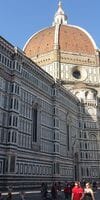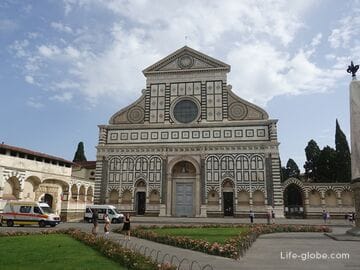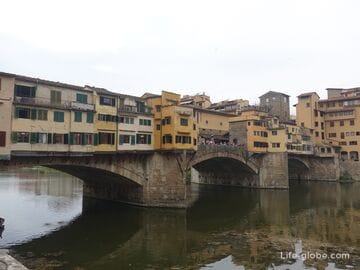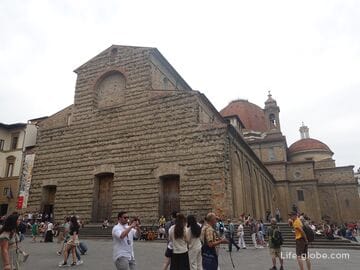The Cathedral of Florence, the full name of which is Santa Maria del Fiore (La Cattedrale di Santa Maria del Fiore, in translation - the Cathedral of St. Mary with a flower) is the main (cathedral) cathedral of Florence (Duomo of Florence), which is a symbol of the city and a magnificent example Florentine Quattrocento architecture.
The Duomo of Florence is the most visited and famous cathedral not only in Florence, but also in the whole of Italy and even outside the country.
The cathedral, crowned with a huge Brunelleschi dome (now an observation deck), rises above the horizon of Florence. And the nearby and detached campanile (Giotto's bell tower) perfectly harmonizes with the building of the cathedral itself and adds color.
This architectural ensemble is clearly visible from many viewpoints of the city.

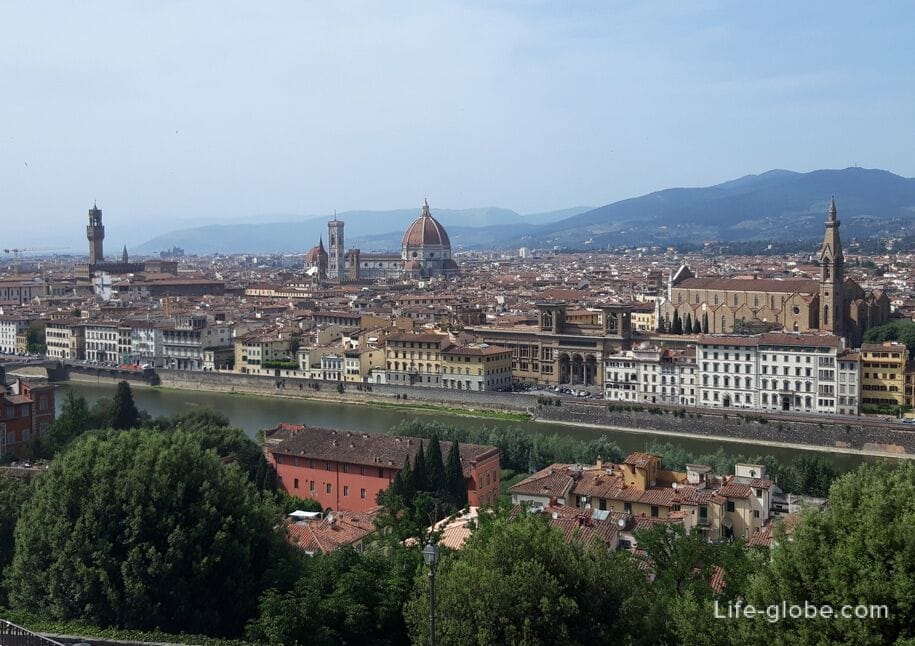
The construction of the cathedral was carried out on the site and above the more ancient Cathedral of Santa Reparata, the remains of which can be visited today.
By the end of the 13th century, the Church of St. Reparata began to collapse, and it was dismantled to the foundation in order to erect a majestic and beautiful main cathedral in this place, which would reflect all the glory of the city.
The first stone of the cathedral was laid on September 8, 1296. The construction was first carried out according to the project of Arnolfo di Cambio, who worked on the cathedral from 1296 to 1302. Arnolfo finishes two spans and half of the new facade.
Then, starting in the mid-1300s, the construction and expansion was carried out according to the project of Francesco Talenti. During the history of the cathedral, other masters also worked on it.
The structural work of the cathedral was completed in 1436, when the dome of the cathedral, erected according to the plans of Filippo Brunelleschi, was completed. Hence the name of the dome - the Brunelleschi dome.
The cathedral was solemnly consecrated by Pope Eugene IV on March 25, 1436 in honor of the Holy Virgin Mary with a lily flower in her hand. The iris flower, or Heraldic lily, is a symbol of the Immaculate Virgin, an attribute of Annunciation, the official symbol and coat of arms Florence.
When the cathedral was completed, in the fifteenth century, it was the largest church in the world.
However, the facade of the cathedral was completed later - according to the project of Emilio De Fabrice, after whose death the work was continued by Luigi del Moro until the completion of the work in 1887. The three large bronze doors of the cathedral by Augusto Passaglia (main central and left side) and Giuseppe Cassioli (right) belong to the period from 1899 to 1903 and are decorated with scenes from the life of the Madonna.
Today, the monumental Florence Cathedral impresses with its grandeur and beauty. It is considered the third largest in Europe, after St. Peter's Cathedral in Vatican, Rome and Milan Cathedral.
The exterior luxurious wall cladding on all sides of the cathedral is made of multicolored marble panels of geometric pattern in various shades: white marble (from Carrara) green (from Prato) and pink (from Maremma) - this is the so-called inlay style typical of the architecture of medieval and Renaissance Tuscany.
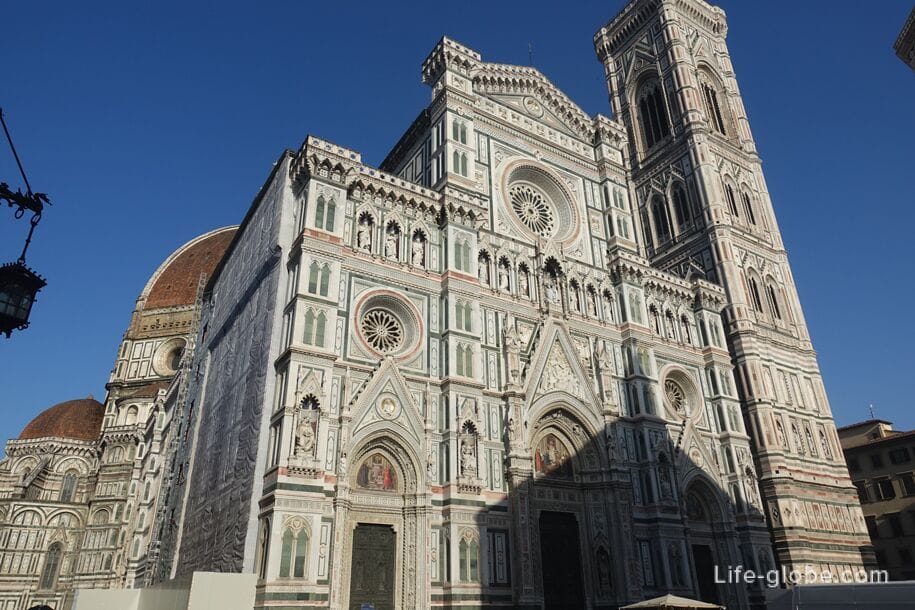
The main, western facade of the cathedral is a kind of stylization of the 19th century under the Gothic style. There are three portals with pointed vimpergs and three rose windows: a large one and two small ones. In the lunettes of the portals, from left to right, there are mosaic compositions designed by Nicolo Barabino and depicting: Charity among the founders of Florentine charitable organizations; Christos on the throne with Mary and St. John the Baptist; Florentine artisans, merchants and humanists paying homage to the Virgin. In the upper part of the facade, under an arched cornice like machicolations, there are statues of the apostles in niches, in the center there is a Madonna and Child. On the pediment of the central portal there is a bas-relief of Tito Sarrocchi with Mary on a throne with a scepter of flowers. In the square caissons above the central rose there are busts of great artists of the past, and in the center of the tympanum of the central pediment there is a tondo depicting God the Father, by Augusto Passaglia.
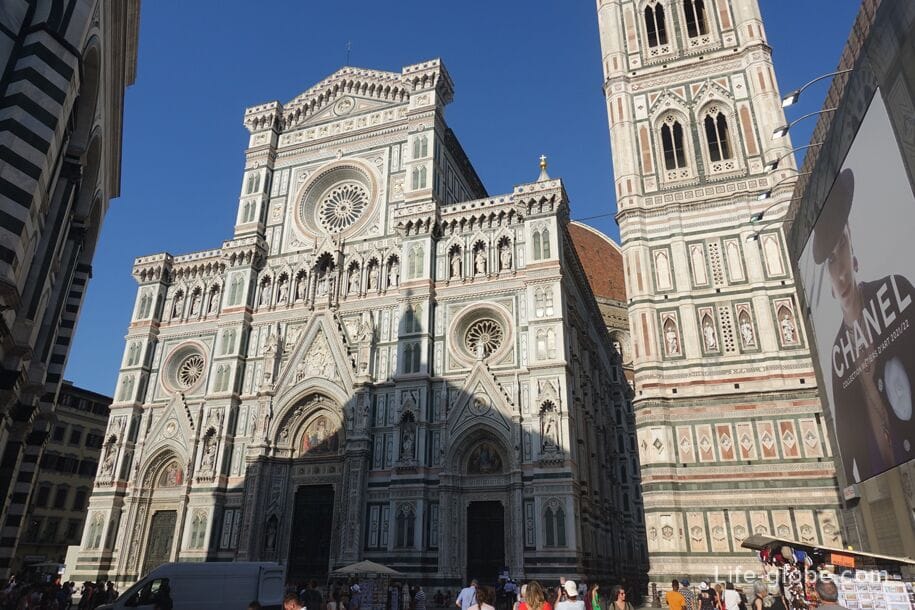
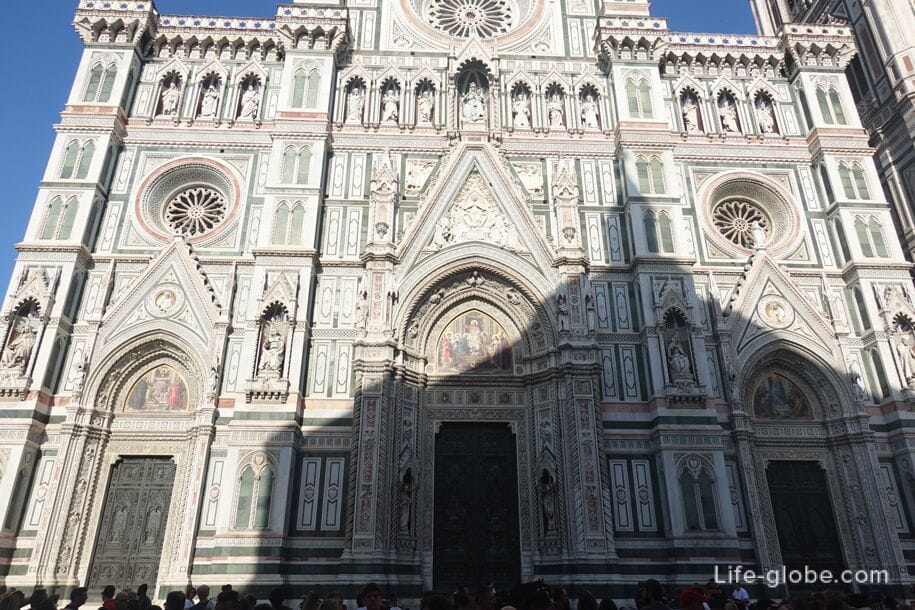
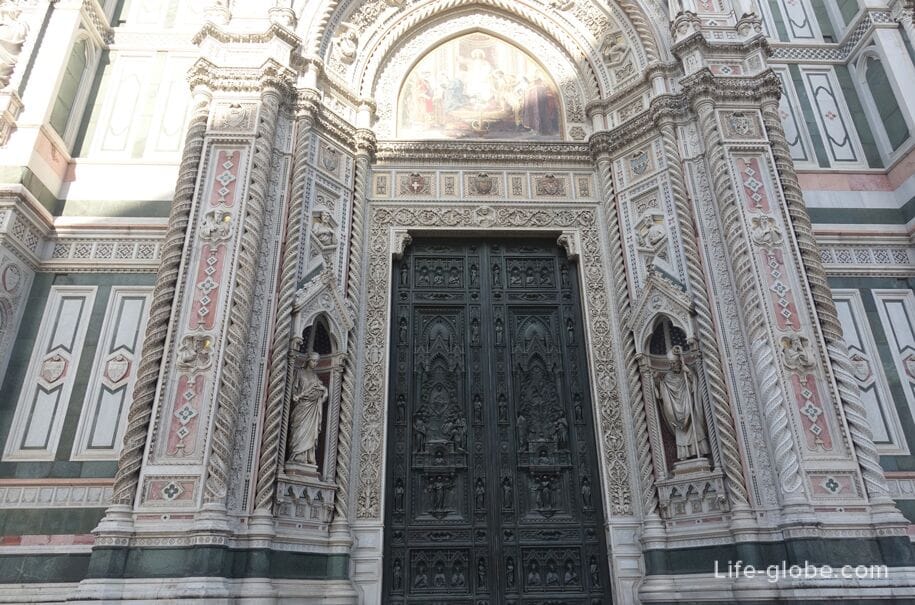
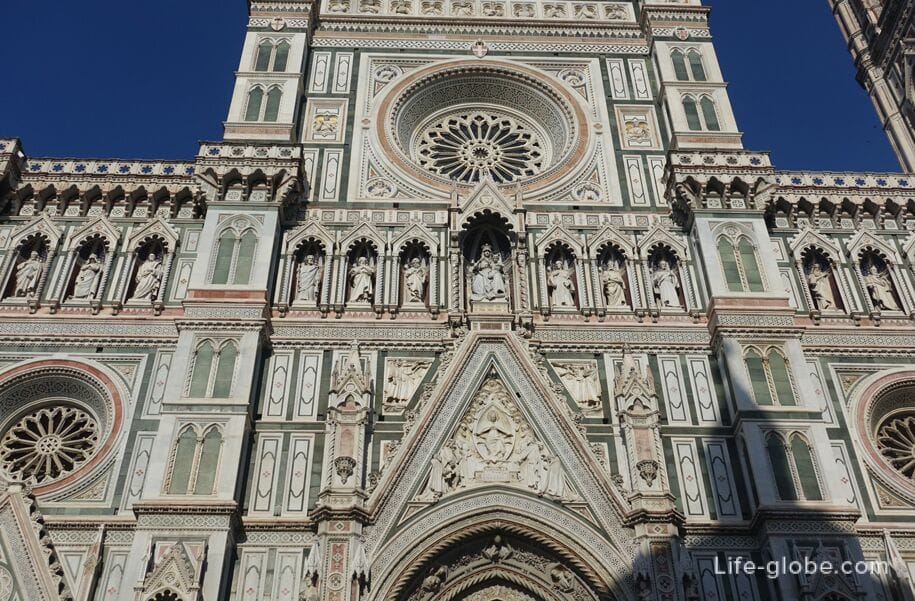

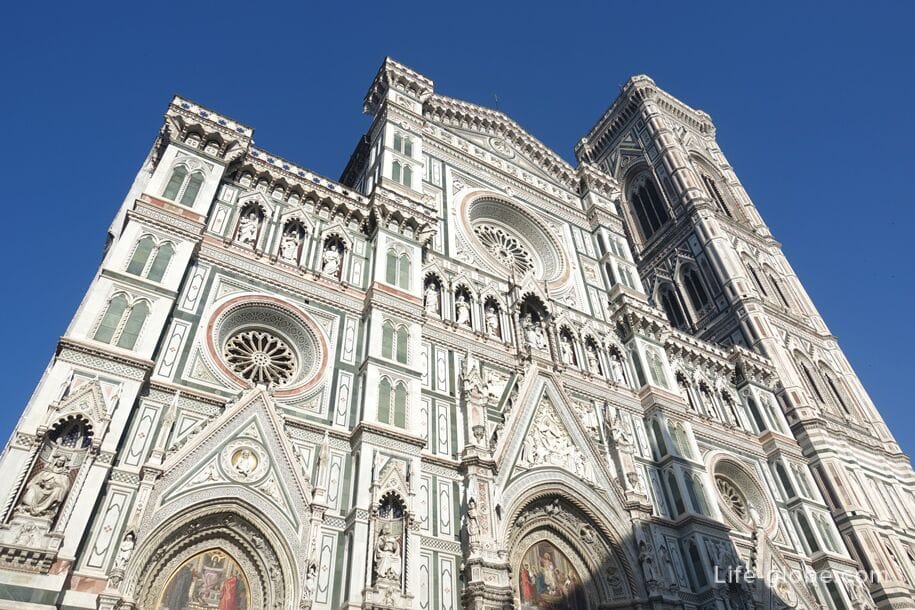
The southern and northern flanks of the cathedral have windows, architectural and sculptural decorations.
The south side (to the right of the facade, from the Giotto bell tower) rose first, up to the first two spans. Here a plaque marks the foundation of 1296.
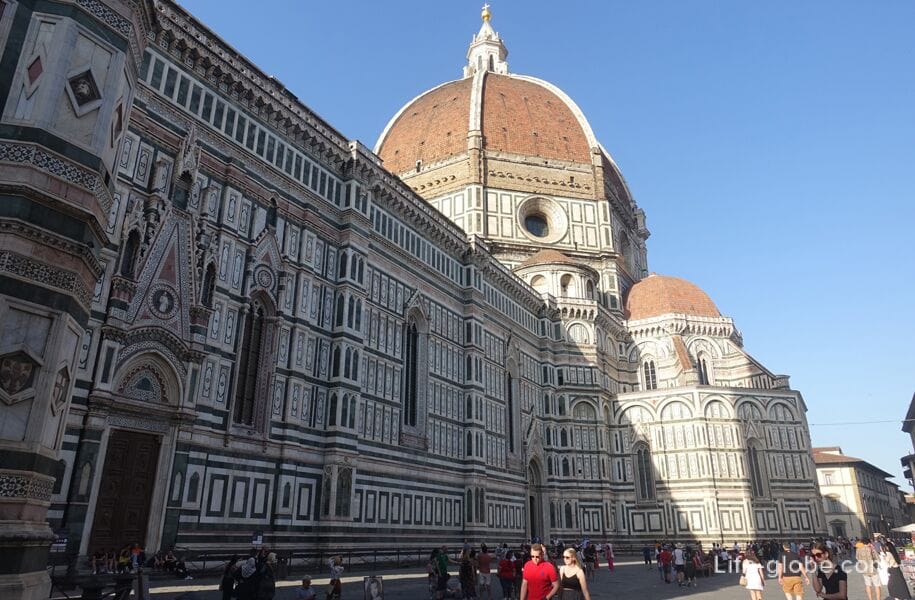
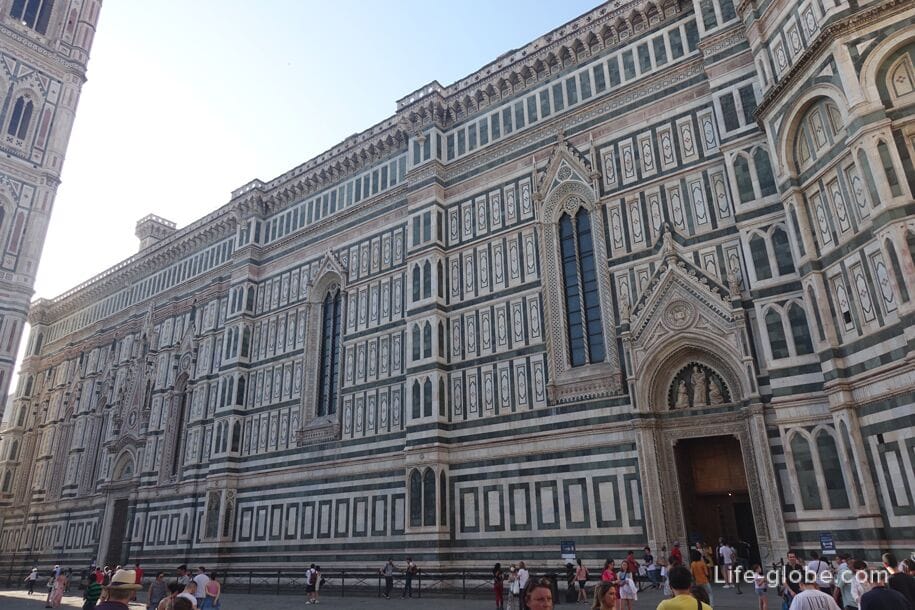
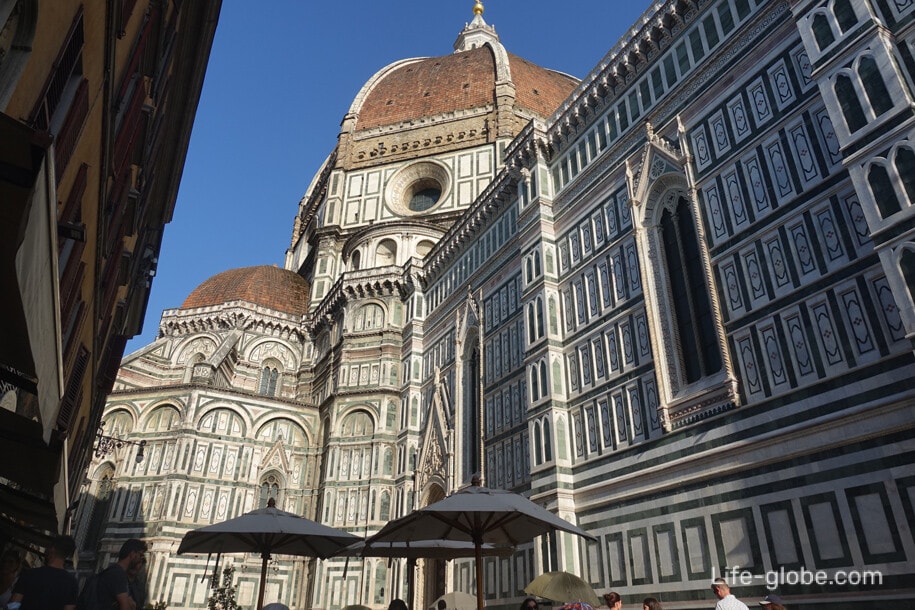
The apsidal part of the cathedral consists of an octagonal dome and three apses.
Three apses, or tribunes, are located on the cardinal directions, prismatic with semi-domes. Above, in accordance with the sacristy and the staircase of access to the dome, there are "dead tribunes" with a semicircular plan, designed by Brunelleschi. Above them there is a continuous gallery on brackets with a four-petalled perforated parapet. Gargoyles in the form of zoomorphic heads protrude under it.
The sculpture "David" by Michelangelo was originally created for one of the buttresses of the northern tribune, but after completion it was exhibited in the Piazza della Signoria near the Palazzo Vecchio (so that the sculpture was more visible), and today the sculpture can be seen in the Gallery of the Academy of Florence. Now a replica (copy) of the sculpture is placed on the cathedral, as well as on the Signoria Square.
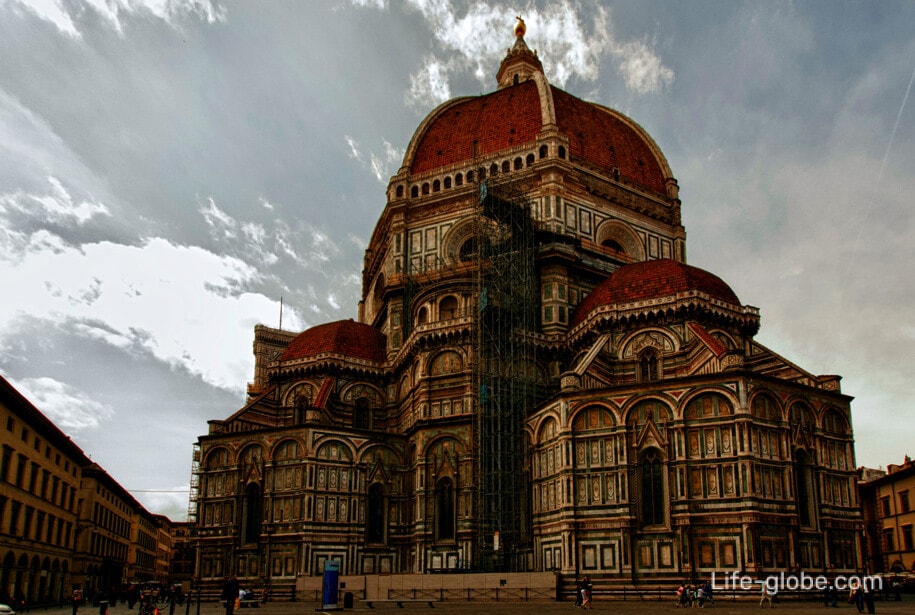
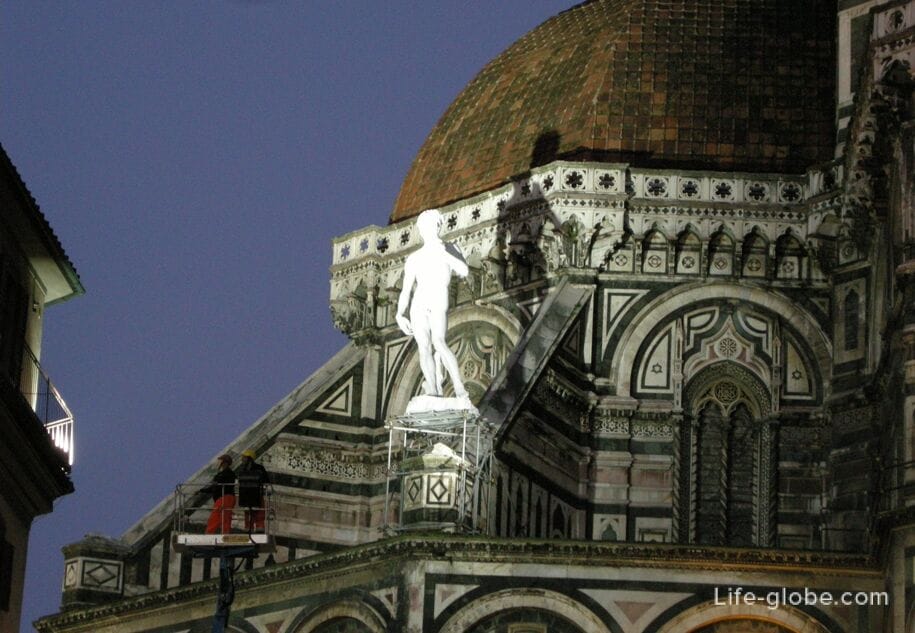
Interior of the Florence Cathedral
Visiting the cathedral is free.
The interior of the cathedral is quite simple and strict in its decoration and has three naves separated by powerful composite columns with arched ceilings.
However, due to the fact that there are no side chapels in the cathedral, and it has pointed arches, its general space creates the impression of infinity.
An internal balcony on consoles runs along the entire perimeter of the temple, at the height of the cruise gate.
The stained glass windows and mosaics were mostly created between 1434 and 1455 based on drawings by Lorenzo Ghiberti, Donatello, Gaddo Gaddi and Andrea del Castagno. They depict characters from the Old and New Testaments, as well as scenes from the life of the Virgin Mary.
There are several organs in the cathedral.

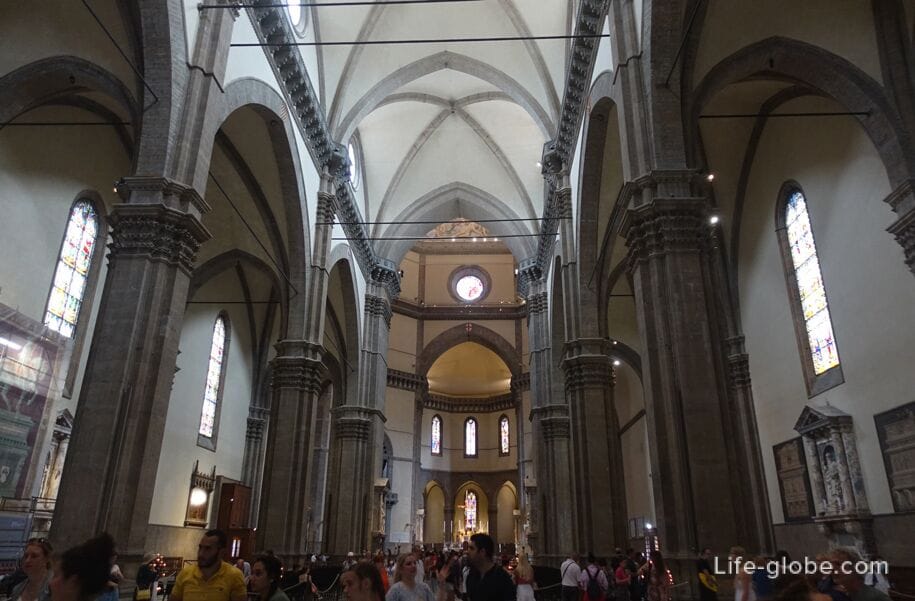
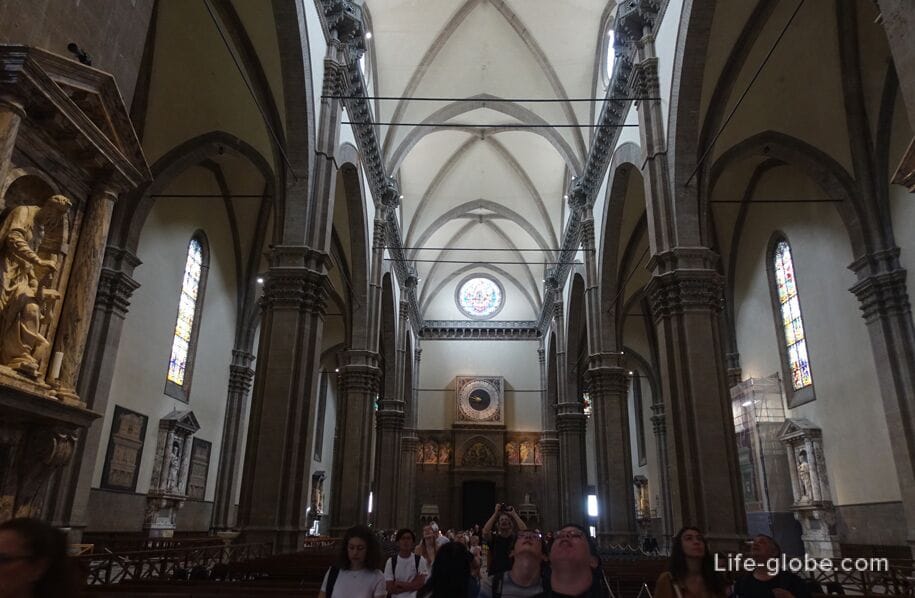
There are also some works of art in the cathedral: statues and busts; the famous fresco by Domenico di Michelino by Alesso Baldovinetti (1465), where Dante Alighieri is depicted with an open book in his hands: "The Divine Comedy", against the background of medieval Florence; the equestrian monument to John Hawkwood (Giovanni Acuto) by Paolo Uccello (1436) and the equestrian monument to Niccolo da Tolentino works by Andrea del Castagno (1456), made in imitation of marble.
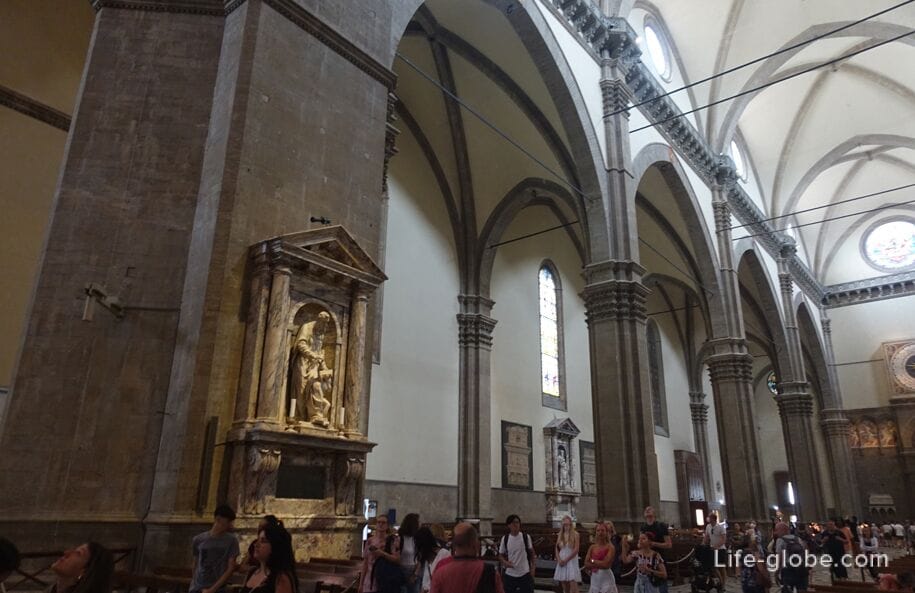
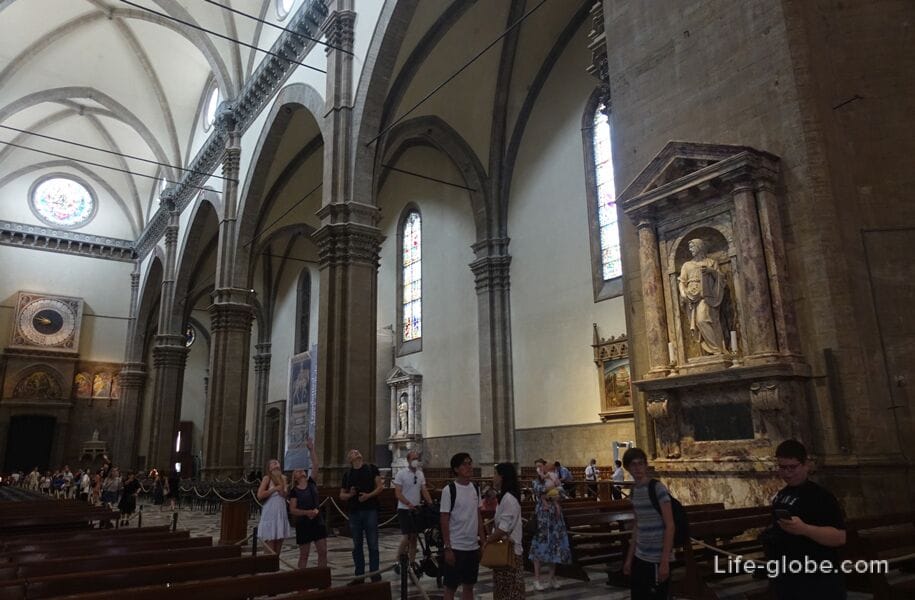
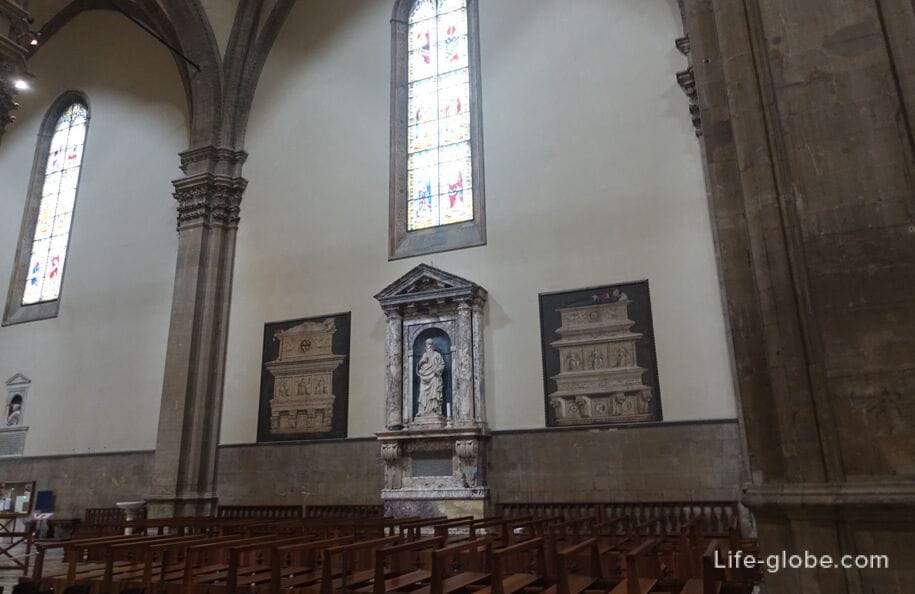
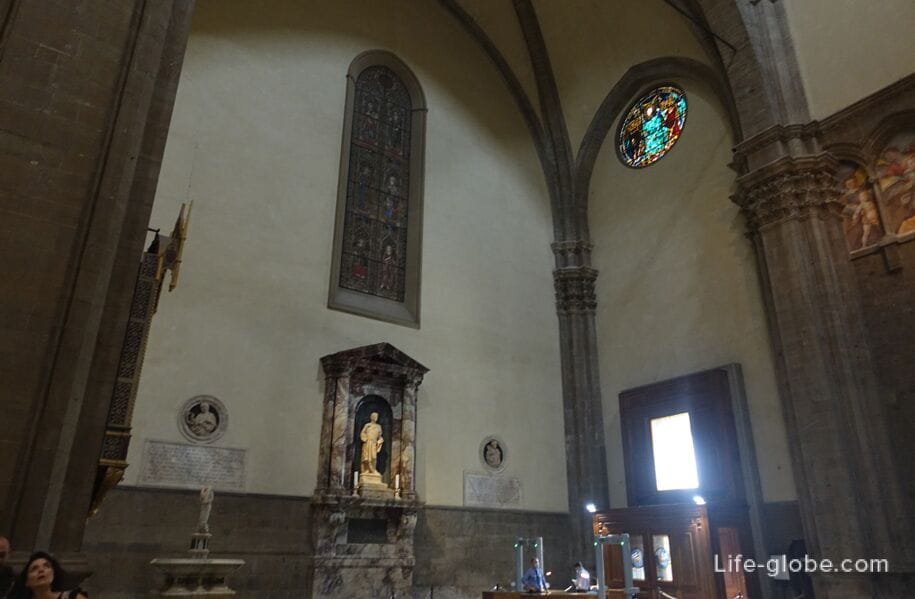
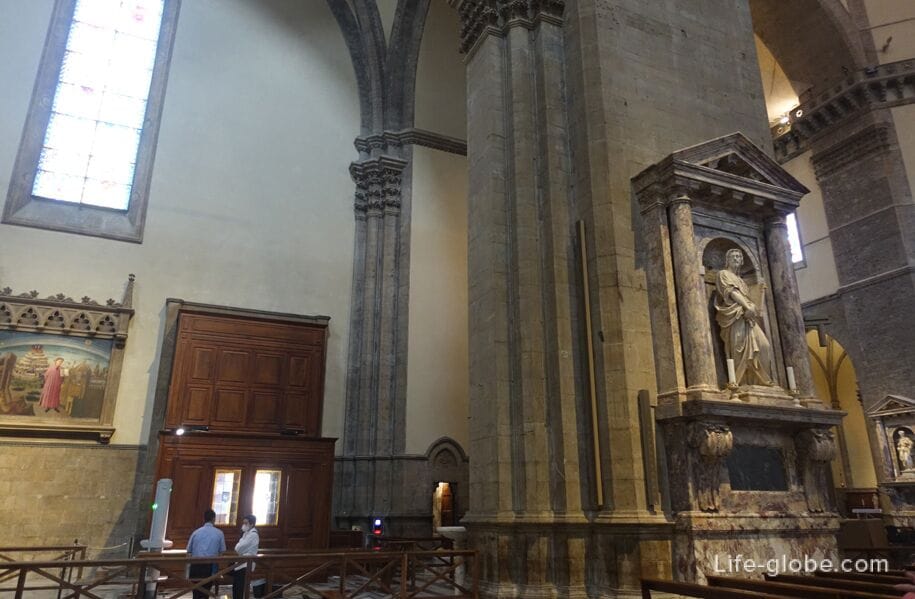
The counter facade has an Italian clock depicting the heads of the Evangelists and frescoes in the corners, by Paolo Uccello (1443). The clock was created in 1443 and runs to this day. They are among the last to use the so-called "hora italica" - a day divided into 24 "hours" of varying duration depending on the season, which begins at the sound of Vespers and is used until the eighteenth.
In the lunette of the central portal there is a mosaic of the Coronation of the Virgin, attributed to Gaddo Gaddi. On the sides of the portal there are angels in an archaic style, possibly painted by Santi di Tito at the end of the sixteenth century. To the right of the central portal is the tomb-sarcophagus of Bishop Antonio d'Orso (1343) by Tino di Camaino. On the adjacent column there is a panel with a golden background depicting Saint Catherine of Alexandria and a devotee belonging to the school of Bernardo Daddi (circa 1340).
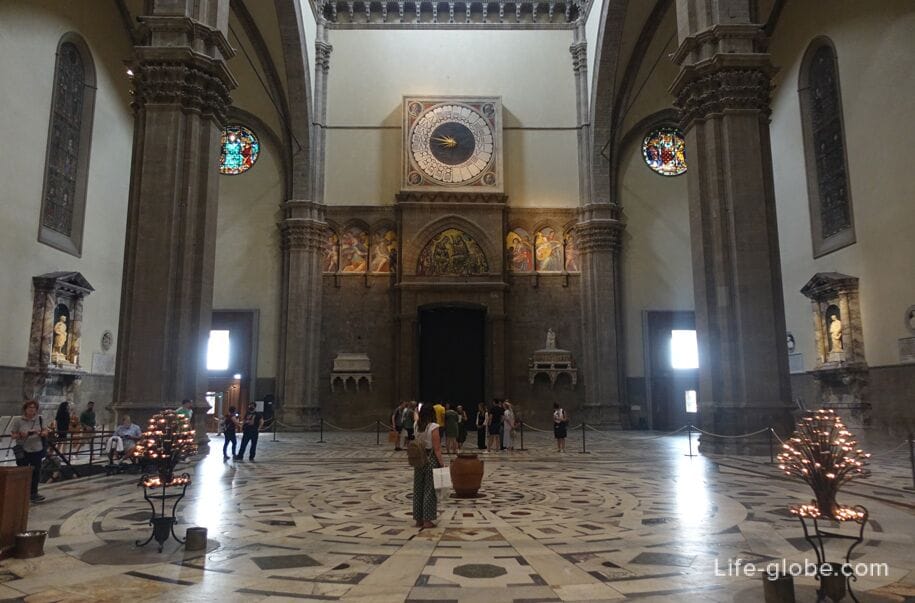
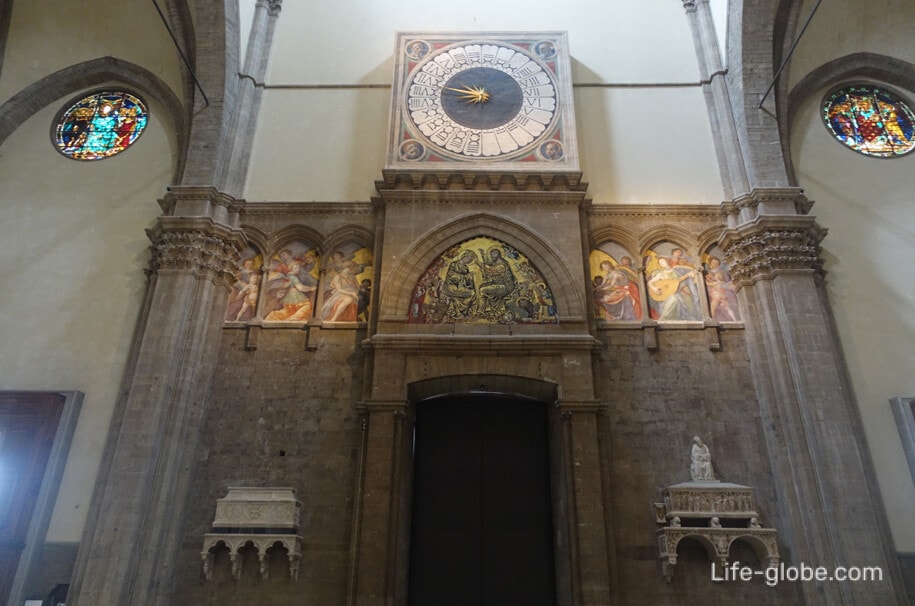
The choir of the cathedral is a space with very large volumes, located under a dome inside an octagon, which then diverges into three stands, at the intersection of which there are two sacristy.
The main altar (placed in 1973 after a liturgical adaptation) with a table resting on four pairs of marble amphorae; behind it a fifteenth-century wooden chair and a sixteenth-century dossal topped with a polychrome wooden crucifix by Benedetto da Maiano (circa 1495). The modern pulpit (2015) is by Etsuro Sotoo, and the Easter candle holder with a marble base and a wooden rod dates from 1477.
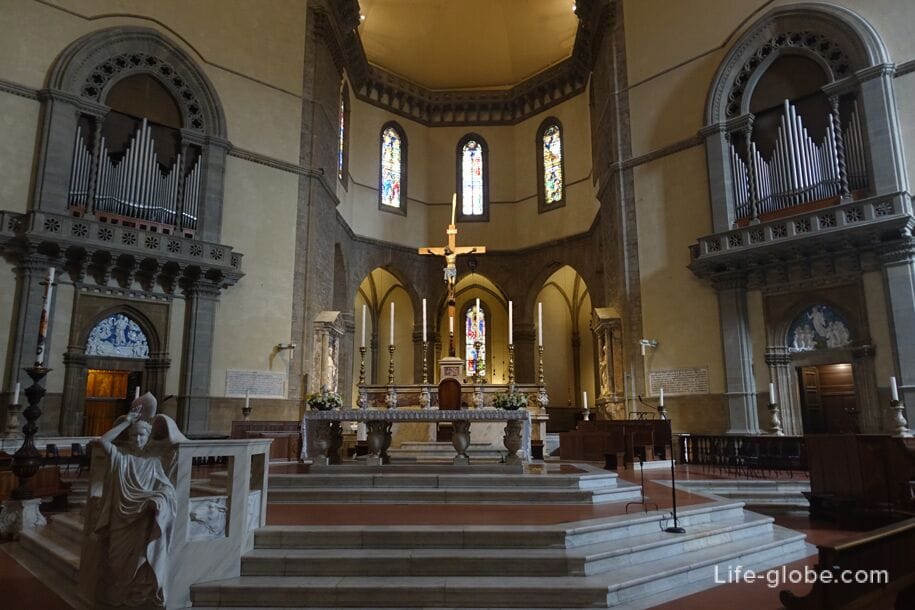
Each of the tribunes (apses) has five side chapels arranged radially, illuminated by high windows with fifteenth-century pillars, mainly related to the design of Ghiberti.
The central tribune, also called San Zanobi, has an altar of St. Zinovy of Florence, where the relics of the Florentine saint and bishop are kept. His bronze ark by Lorenzo Ghiberti was completed in 1442.
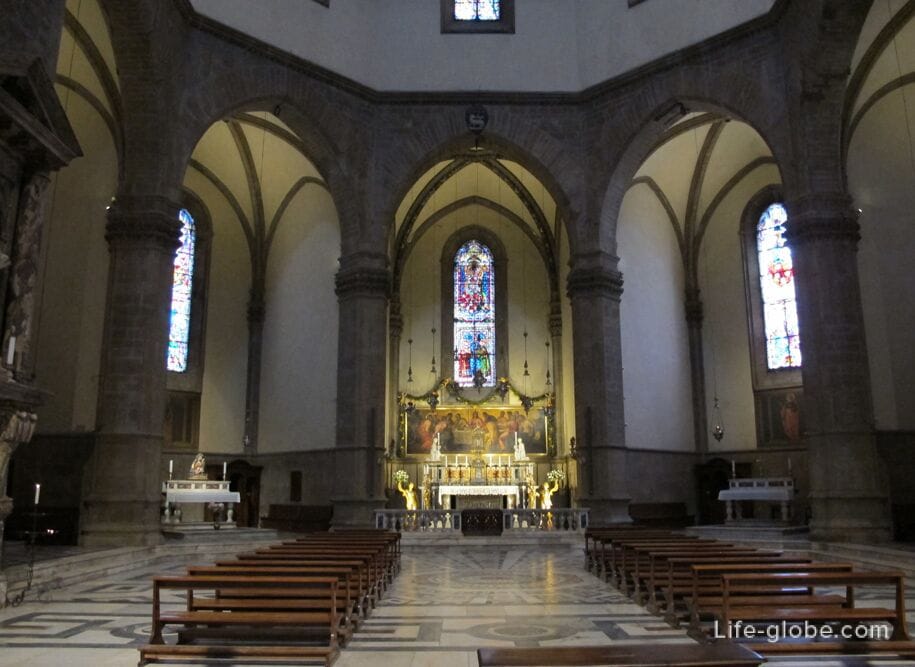
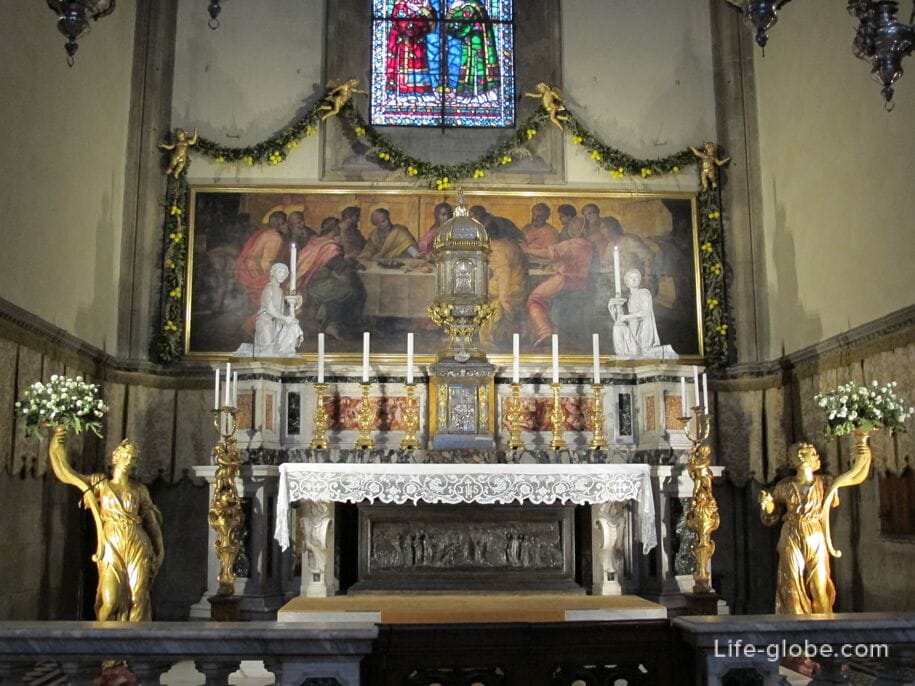
Below the chapel of San Zanobi is a crypt with a quadrangular plan, in which there are burials of some archbishops of Florence (including Silvano Piovanelli and Ermenegildo Florit), sarcophagi of San Podio and Saints Andrea and Maurizio, relics of Saints Eugene and Crescentio and an ancient urn in which the remains of San Zanobi were kept.
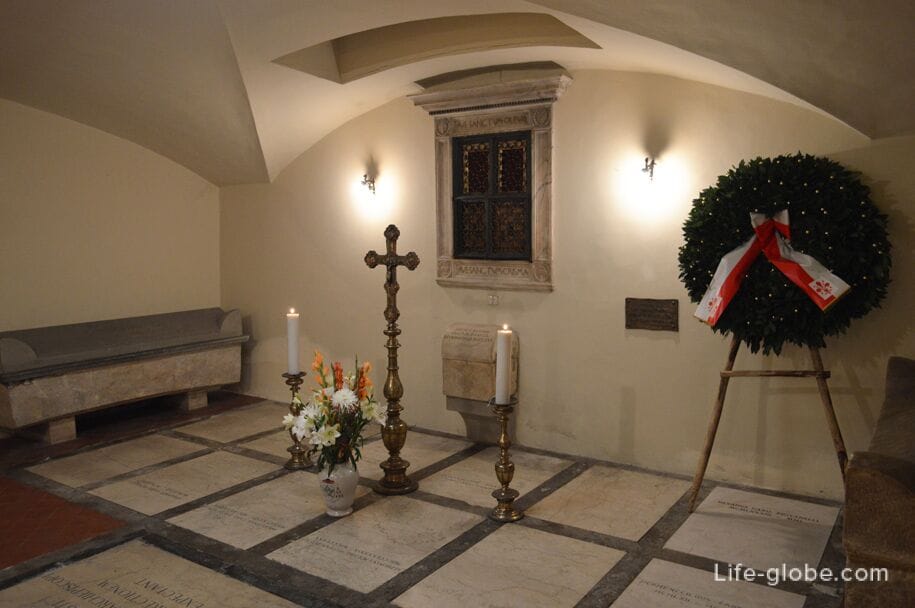
In the gallery on the right, known as the "Santissima Concezione", a central chapel with an altar by Michelozzo stands out.
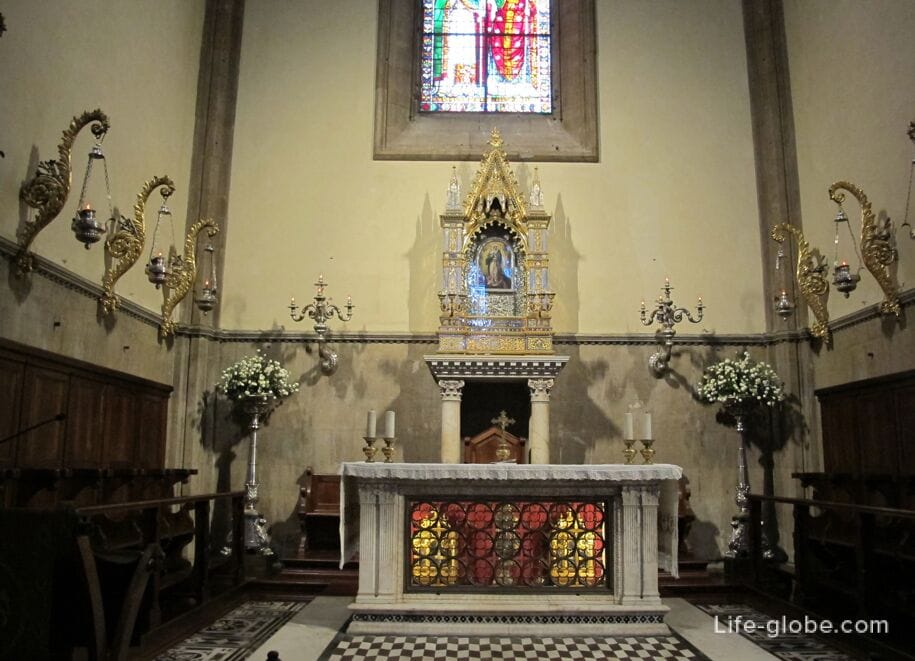
The left tribune, known as the Holy Cross, contains in the floor a "solar gnomon" by Paolo dal Pozzo Toscanelli circa 1450 with a graduated bronze line (created in 1755 by Leonardo Jimenez). Every year, a sunbeam through the window of the nave on the opposite side of the cathedral shows the summer solstice - June 21.
In the second chapel on the right, dedicated to the Madonna della Neve, there is a polyptych of Santa Reparata with two faces of Giotto and assistants; in the third - a marble altar of Bugiano with a bronze lattice by Michelozzo; Cardinal Elia dalla Costa is buried under the altar of the fourth chapel, and in the fifth chapel Saint Joseph is depicted on a panel by Lorenzo di Credi.
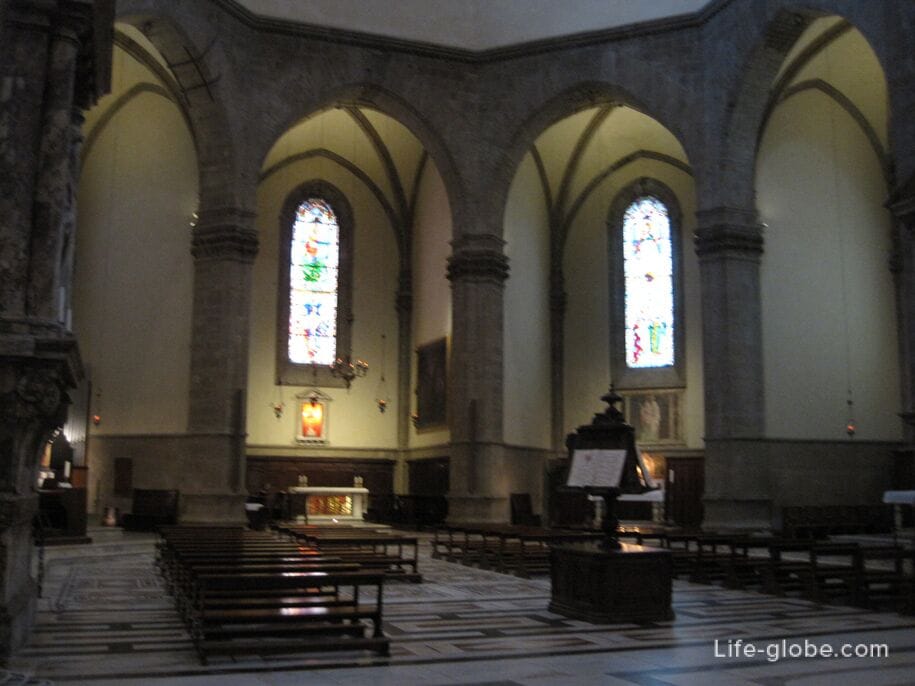
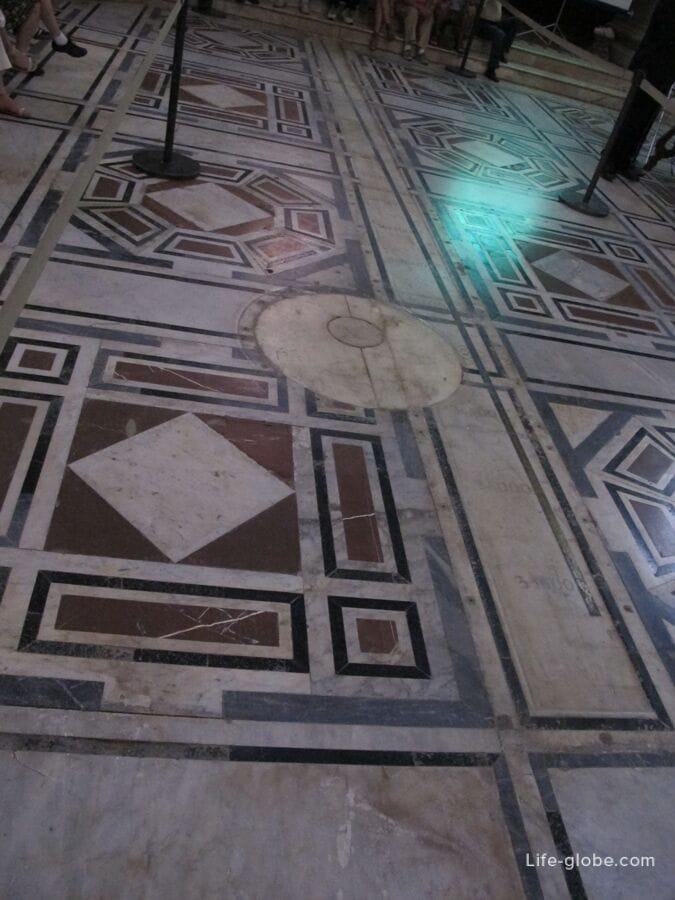
Crypt under the cathedral (Santa Reparata)
Under the Cathedral of Santa Maria del Fiore is the so-called crypt of Santa Reparata (Cripta Santa Reparata) - a former church, from which the remains of the former Cathedral of Florence now remain, over which the current Cathedral of Florence was erected.
The remains of an ancient early Christian basilica were discovered between 1965 and 1973 during excavations under the Cathedral of Santa Maria del Fiore. These remains of the ancient Basilica of Santa Reparata are the largest and most reliable evidence of early Christianity in Florence.
Here you can see the remains of walls and mosaic floors, as well as tombstones, parts of frescoes and several showcases with exhibits.
The entrance to the crypt is located inside the current cathedral (on the south side). Steps lead to the crypt.
A visit to the crypt is paid (included in the Duomo package tickets). More about Santa Reparata Crypt…
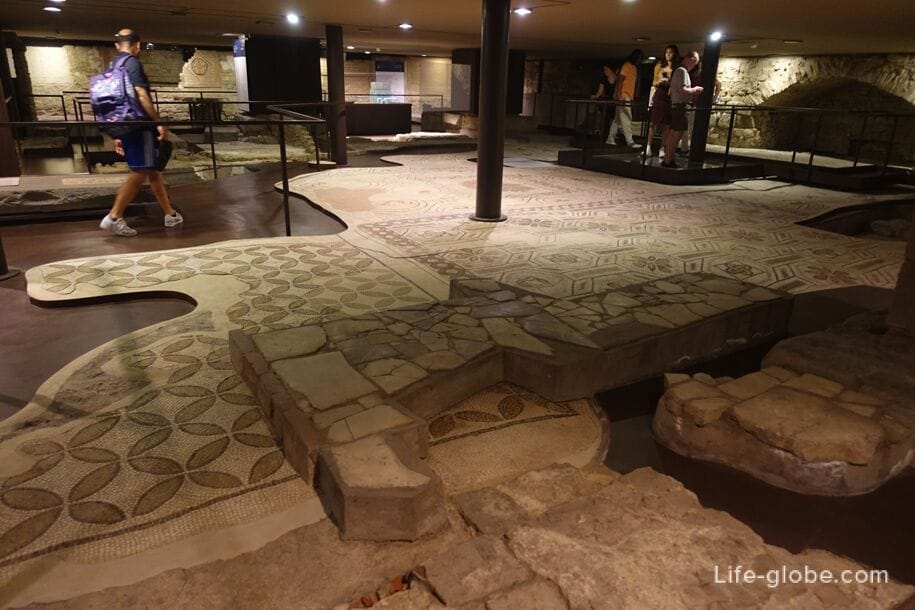
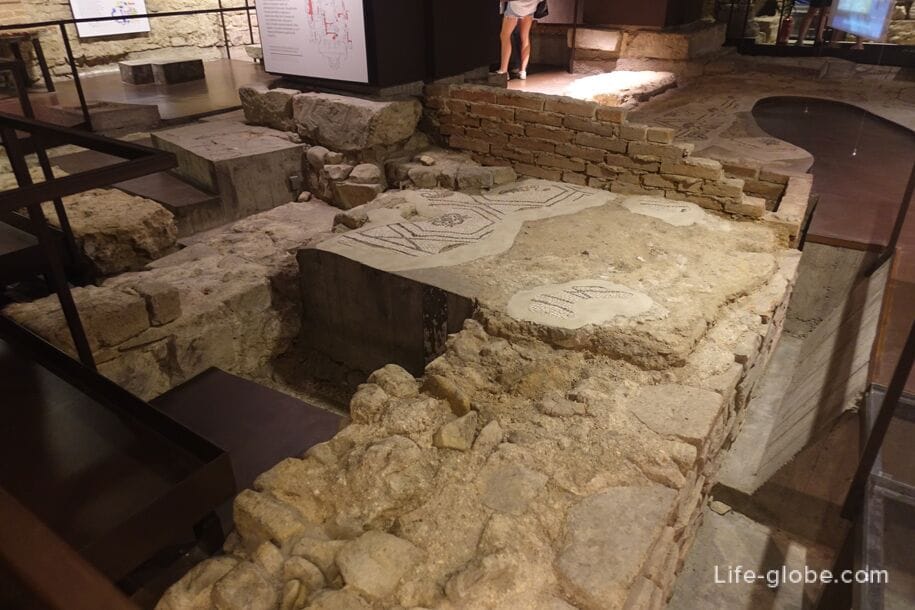
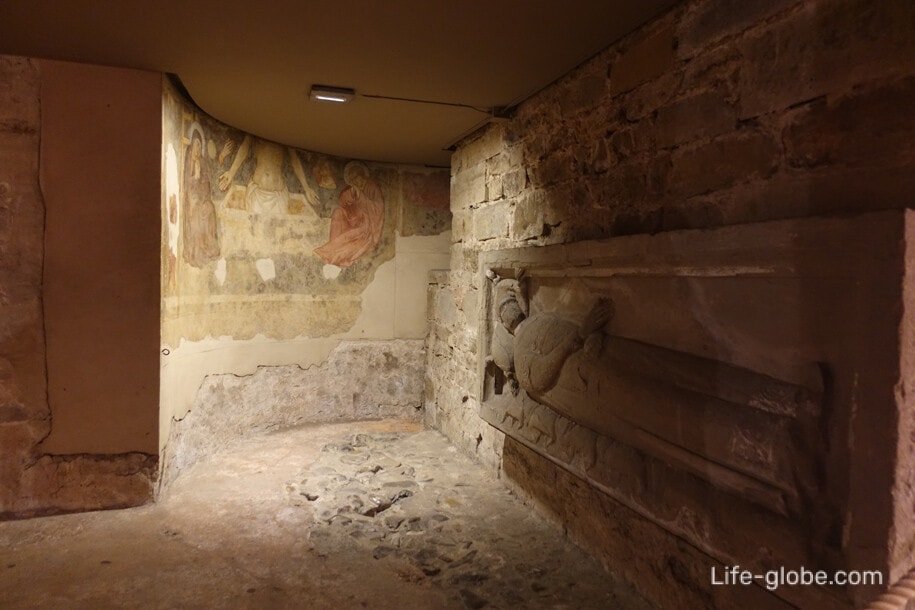
The dome of the cathedral
The Cupola del Brunelleschi with a diameter of 45.5 meters and a total height of more than 116 meters is the largest stone vault in the world.
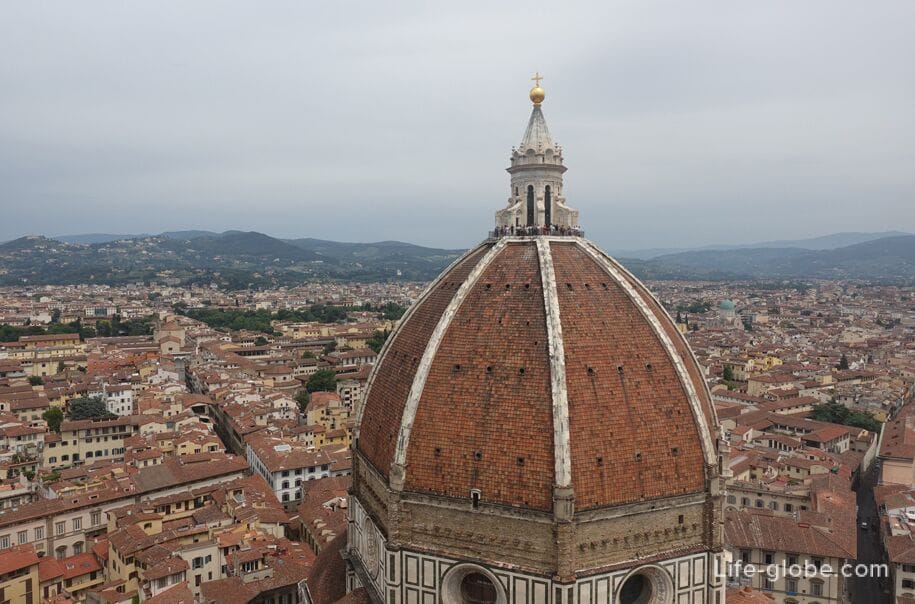
The magnificent huge dome of the cathedral is painted from the inside with frescoes in 1572-1579 by Giorgio Vasari and Federico Zuccari on the theme of the Last Judgment.
Inside the dome there are two rows of galleries, one of which you can walk through and admire the dome up close, when climbing to the observation deck of the dome.
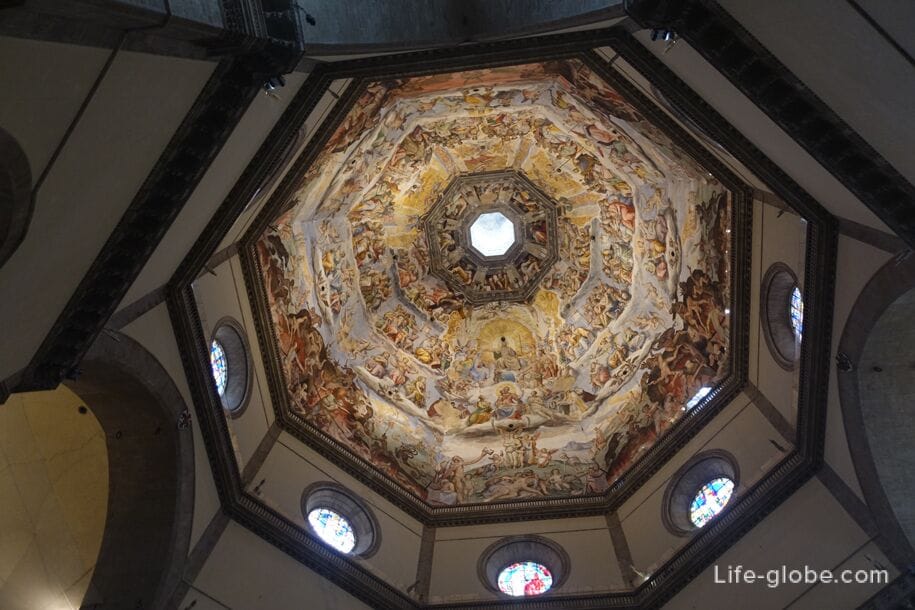
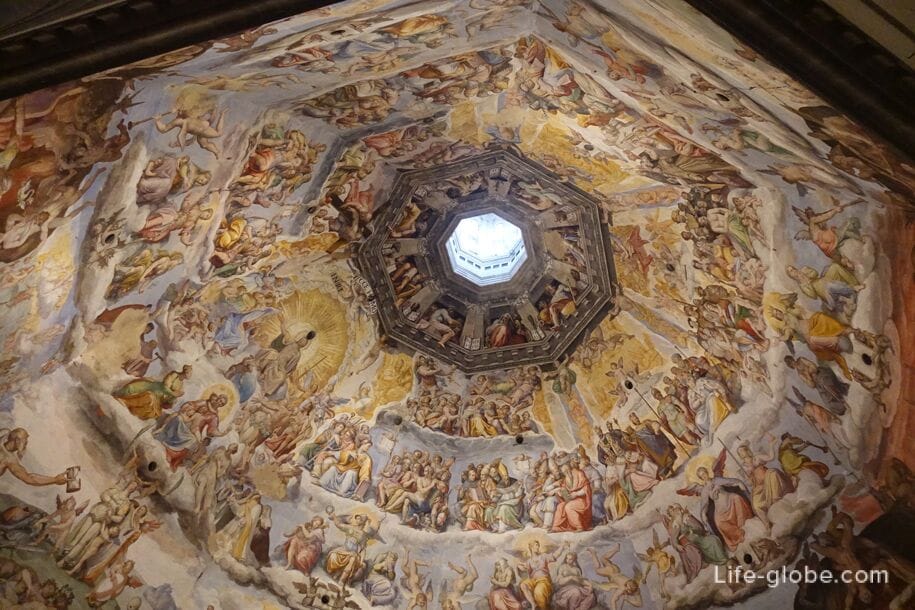
Climbing the dome, you can go to the open 360-degree observation deck, which offers stunning views of the whole of Florence and even beyond the city.
The observation deck is located at an altitude of 92 meters.

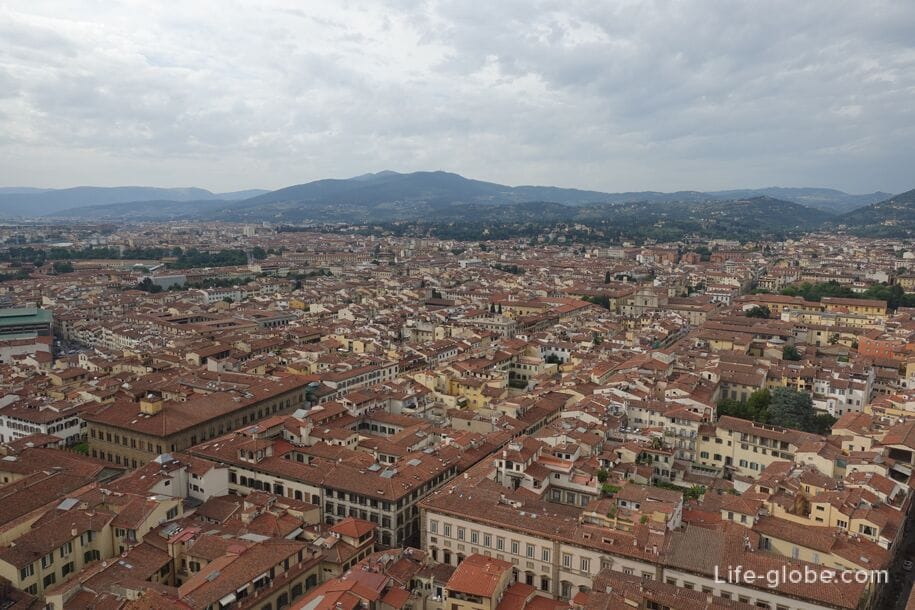

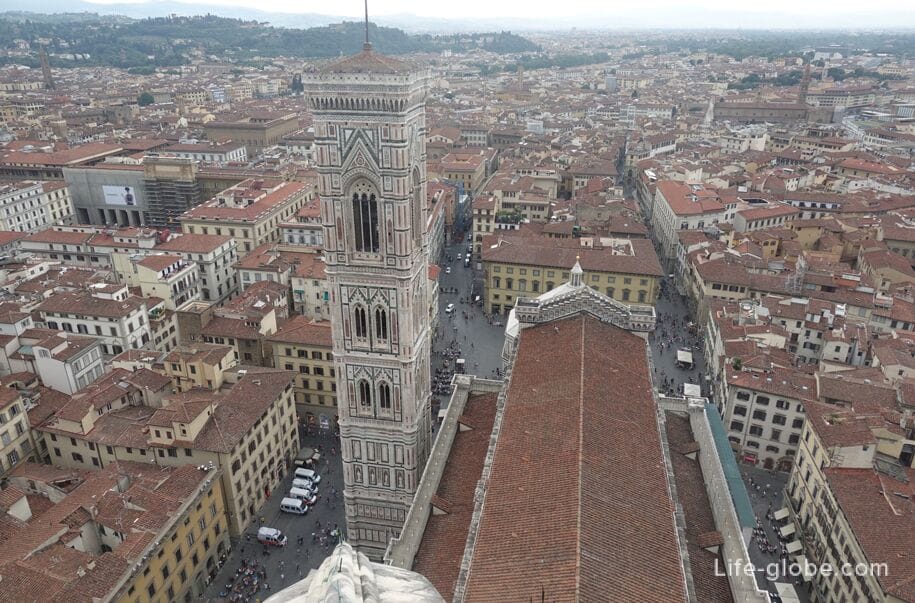
The entrance to the ascent to the dome is located on the north side of the cathedral, from the Porta della Mandorla (Porta della Mandorla) from the Duomo Square (Piazza del Duomo).
A total of 463 feet lead to the dome (there is no elevator).
The ascent under the dome is carried out by a spiral staircase. When climbing, you can see a small exposure.
The ascent to the dome is paid (included in the Duomo complex ticket). Learn more about the dome, observation deck, views and ascent…
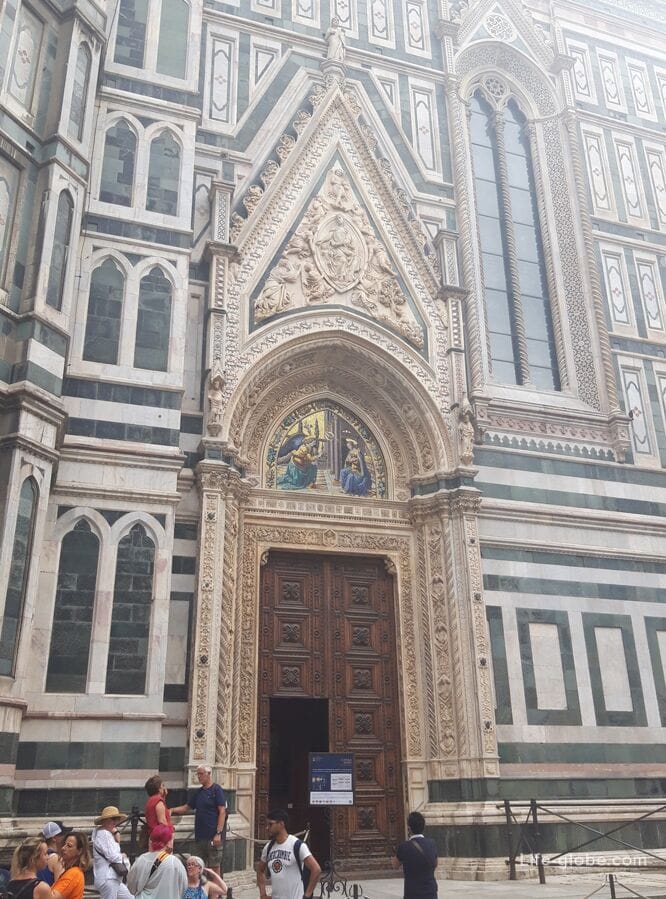
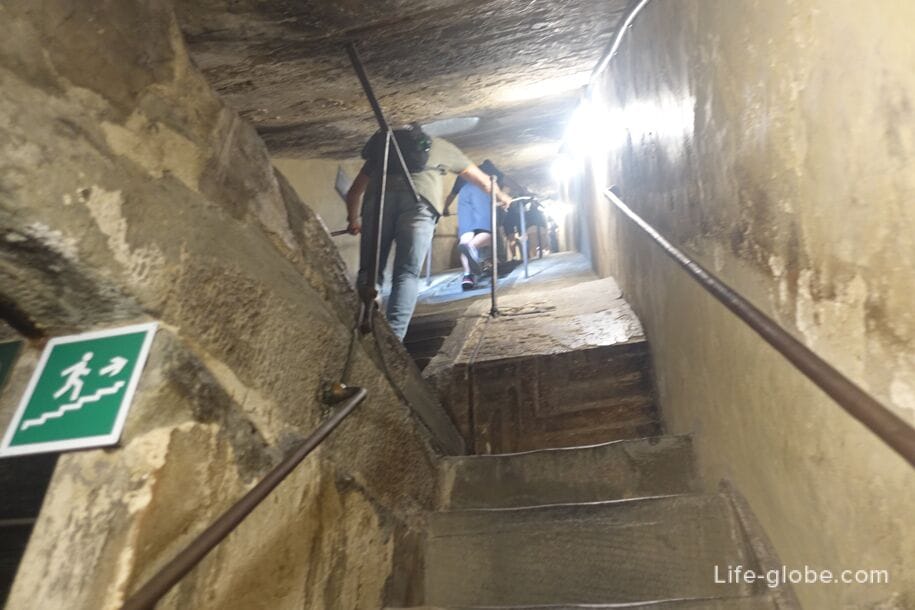
Cathedral terraces
At the height of the roofs of the side aisles of the cathedral (32 meters), from the outside of the cathedral there are terraces where you can climb and admire the views of Florence.
The terraces consist of a solid balcony on consoles, decorated on the outside with a marble balustrade perforated with quadriboles.
Along the northern and southern terraces, which are currently accessible and each about 70 meters long, one can closely see the marble details of the rose windows and the covering of the main nave, where one can see the presence of openings for pontoons, and the brick roofs of the naves, under which the attic rooms of the cathedral are hidden.
At the end of the route you can see the "blind" tribunes of the cathedral, which in 1439, in order to strengthen the stability of the dome of the cathedral, Brunelleschi designed.
Visiting the terraces is possible upon prior request with the guides of the cathedral.

Bell Giotto
Next to the cathedral is the detached Giotto Bell tower (Campanile di Giotto, Giotto's Campanile), which is an outstanding example of Florentine Gothic architecture with rich sculptural decorations and polychrome marble inlays.
The bell tower received the name "Giotto" from its designer and creator of its first tier - the Italian architect and painter Giotto di Bondone.
The construction of the bell tower was started in 1334 and completed in 1359.

The bell tower is 84.7 meters high and about 15 meters wide.
The bell tower can be climbed; there is a 360-degree observation deck, which offers beautiful views of the whole of Florence and even beyond the city.
The ascent to the observation terrace of the bell tower is carried out by stairs (there is no elevator), with a total of 414 steps.
During the ascent, guests are accompanied by three viewing platforms and the last one, located at the very top - the terrace of the bell tower (height 82 meters). The higher you climb, the more picturesque the views are.
The ascent to the Giotto observation bell towers is paid (included in the Duomo package tickets). More about Giotto's Campanile, viewing, views and ascent…
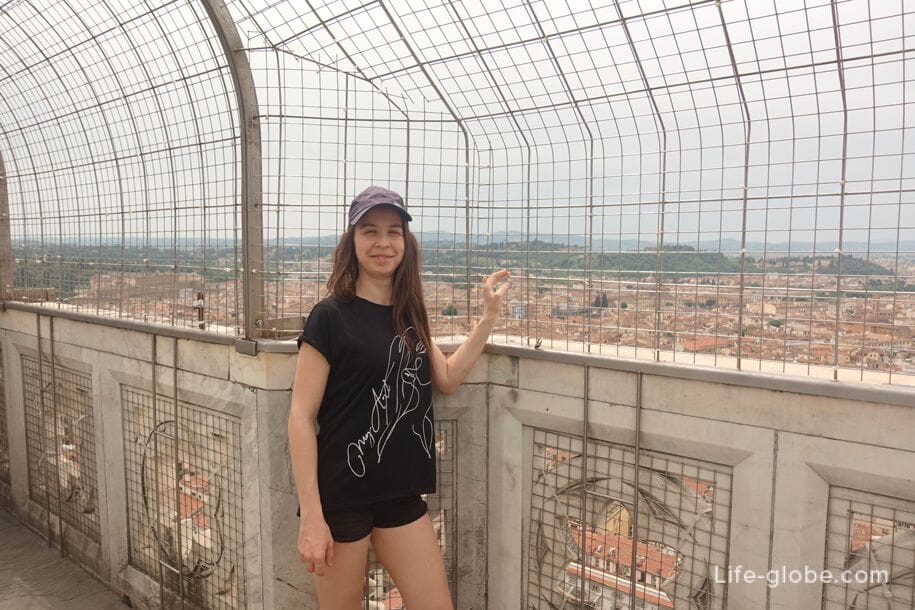
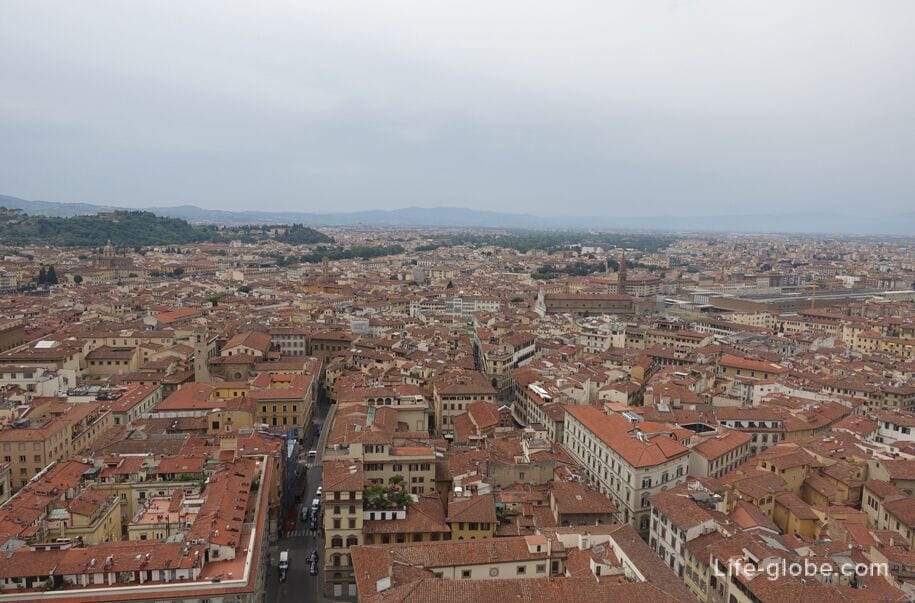
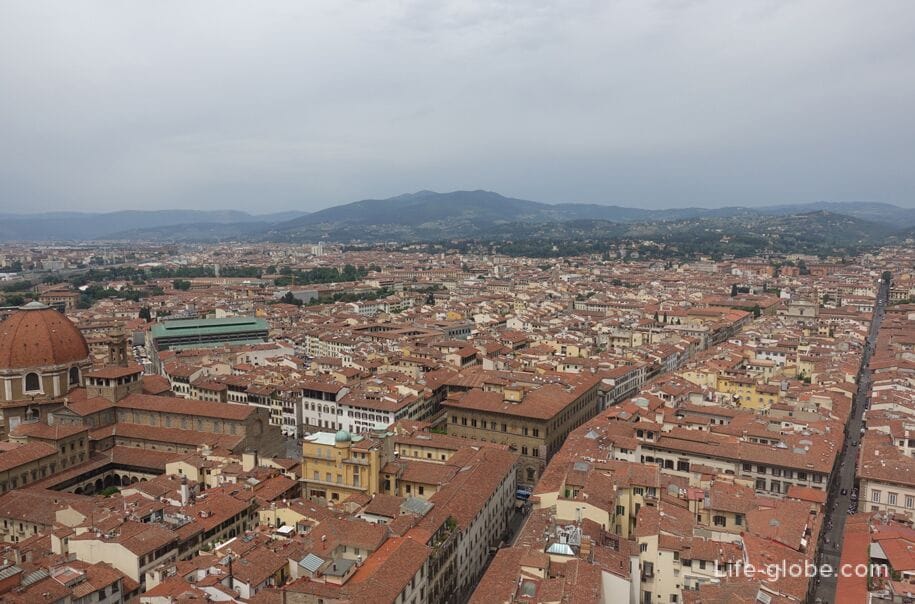
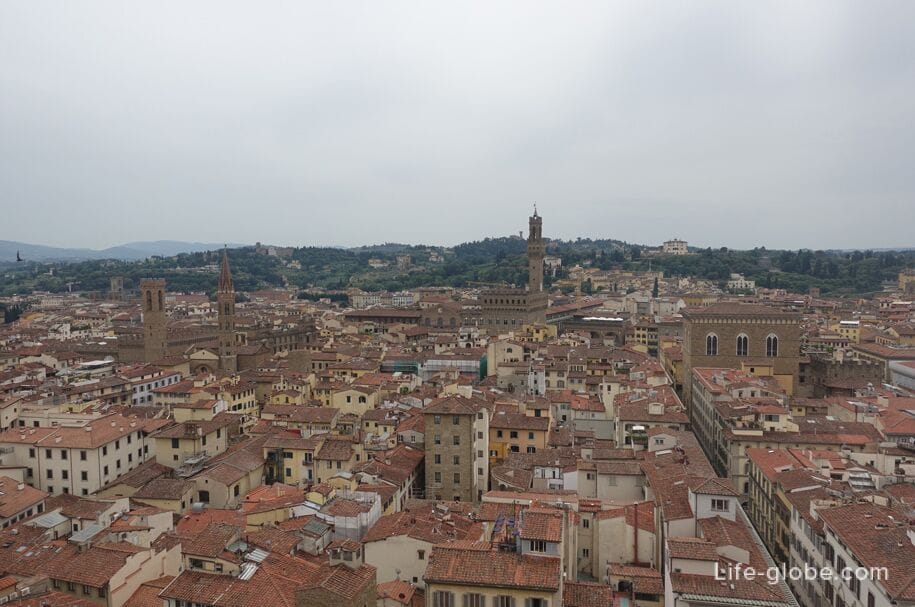
Most of the important works of art of the cathedral and the bell tower of Giotto were removed and replaced with copies. The originals are now stored in the Duomo Opera Museum, which can be visited for a fee, and tickets to which are included in the package tickets for visiting the Duomo complex. More about the Duomo Opera Museum...
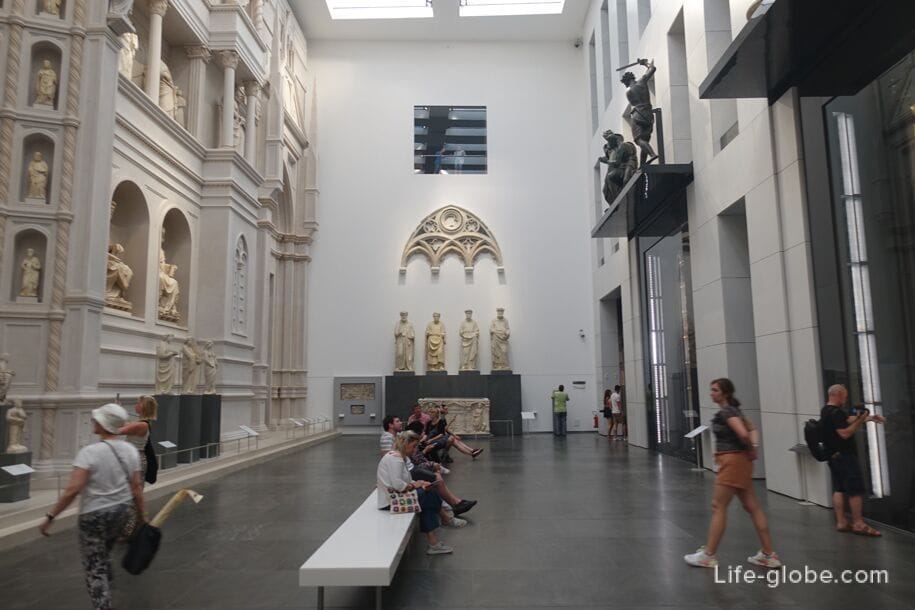
Practical information
Entrance to the Cathedral of Florence is free.
A visit to the crypt of Santa Reparata under the cathedral, a climb to the Brunelleschi dome, a visit to the Duomo Museum and the Giotto Bell tower - paid, by ticket.
Visits to these objects of the cathedral, as well as the nearby Baptistery of San Giovanni, are included in the single ticket of the Duomo complex. The ticket is valid for 3 days.
To climb the dome, you must select the time of ascent in advance (when buying a ticket), by which you will have to approach the entrance to the ascent to the dome. All other paid facilities of the complex can be visited at any time of the ticket validity.
Tickets can be purchased online or at the ticket offices (information centers) on the square near the cathedral. There are various variations of tickets.
Visiting the terraces of the cathedral is possible accompanied by a cathedral guide with excursions, which must be booked in advance and paid separately from the complex tickets to the Duomo complex.
We recommend you to check the exact and detailed information about tickets and their cost, the opening hours of the facilities of the complex, the available free time for recording the ascent to the dome, excursions along the terraces of the cathedral, etc., on the official website of the complex: duomo.firenze.it.
The Duomo complex is located in the heart of Florence, on Piazza del Duomo.
Coordinates of the Duomo of Florence: 43°46'23.0"N 11°15'23.0"E (43.773056, 11.256389).
All accommodation facilities in Florence (hotels, apartments, guest houses, etc.), including in the historical center of the city and more remotely from it, can be viewed and booked here




